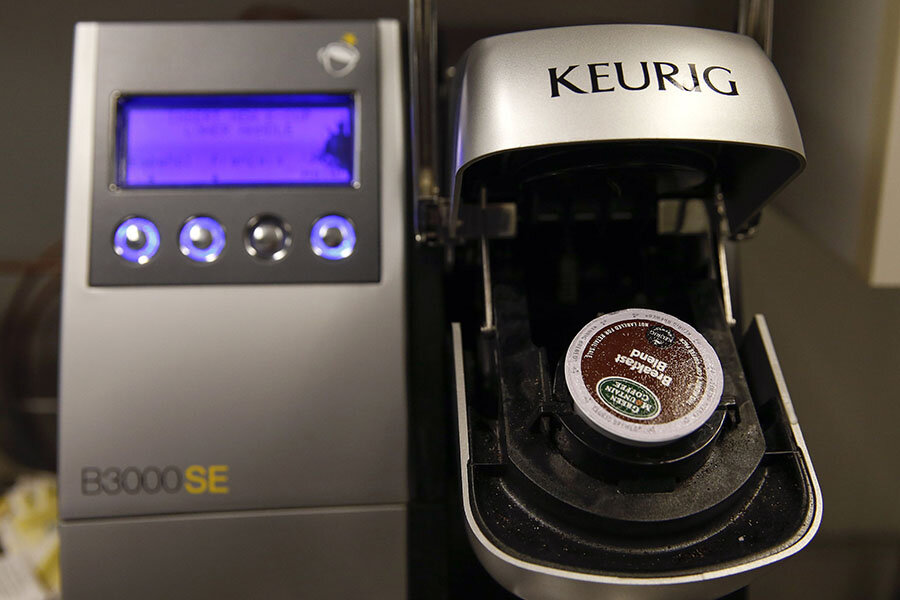How to ease your K-Cup conscience
Loading...
There’s a sad truth about the all-mighty K-Cup: It’s horrible for the environment. And by horrible, we mean that it’s not recyclable and the majority of them wind up in landfills or, worse, floating around in the Great Pacific Garbage Patch. It’s estimated that the amount of cups sold in 2014 alone could circle the earth 10 to 12 times or more! We’re talking billions of K-Cups every year.
Keurig Green Mountain’s Chief Sustainability Officer Monique Oxender, admitted to The Atlantic Monthly that it was a big issue. “I gotta be honest with you,” Oxender told them, “we're not happy with where we are either. We have to get a solution, and we have to get it in place quickly.” They're trying, but don't plan on having anything until 2022! Also, in that same article, even the inventor of the K-Cup, John Sylvan, confessed that he sometimes regrets having ever devised it in the first place.
But if nicotine is the drug that drives cigarettes sales, convenience is the addictive additive that keeps the Keurig Coffee Brewer king. Sales have never been better. The ease of making yourself a cup of coffee in seconds without having to think about it is just too powerful to resist. That power is proven by another awful truth many already know: Keruig coffee is way more expensive than regular coffee.
Even the best sales we’ve seen on K-Cups only bring the average price per cup down to around $0.41/cup, maybe $0.39/cup if we are really lucky. But if you compare that to a 28oz canister of basic coffee that costs $9 and can generate 120 cups at around $0.08/cup, you don’t need to go to M.I.T. to understand what that math is telling you. Even more expensive ground coffee winds up being cheaper per cup if you just make it the old fashioned way. K-cups are never a deal.
Furthermore, (and this part is a bit more subjective) you’ll almost never hear anyone say, “I like the way it tastes better,” when talking about Keurig brewed coffee. In general, because of the rapidity of how it is made, cups of pod coffee are more watery and less robust in flavor than their traditional counterparts. But does that matter? Sales say no. None of this wins out over the drug of convenience.
So what to do?! Do you hate the waste but also don’t want to give up your precious brewer? We’ve got some solutions for you.
The Reusable Cup
Get this reusable K-Cup on Amazon!
The easiest way to take the disposable K-cup out of the equation is to buy a reusable one. This allows you to accomplish two things: 1) Stop yourself from adding to that earth circling volume of waste and 2) save money by using coffee grinds that cost much less than those pre-loaded cups.
There are a few drawbacks. For starters, you have to load it with grinds every time you want a cup. Then, you have to clean the filter each time, too. Spillage inevitably happens in either step of the process. That’s kick in the old convenience can.
But it's a small price to pay and several companies make them. Just make sure which ever one you buy works with your model of brewer. Not all of them will work with all brewers, especially with Keurig's newer 2.0 versions.
Here’s a list of some and links to where you can get a few of them for the lowest price.
- Keurig My K-Cup Resusable Coffee Filter $7.79 on Amazon
- EkoBrew Refillable K-Cup For Keurig K-Cup Brewers 2 for $7.99 at Kmart
- Ekobrew Refillable K-cup for Keurig 2.0 for $11.99 on Amazon
- Mind Reader Reusable Metal K-Cup Coffee Pod $6.99 at Amazon
Go Back to Your Roots
Why not make a whole pot of coffee tomorrow?
When programmable coffee makers came out, they were a must-have item. Sadly, they've taken a back seat to the Keurig brewer in the last few years, but it's made companies get more clever about making their brewers more convenient. Take this Hamilton Beach 2-Way Brewer ($79.85 at Walmart), for example, which can brew a 12-cup pot or just a single serving up to 14oz. Program it to start brewing in the morning and you are good to go.
And here are some other cool, convenience brewers:
- Cuisinart Programmable Coffeemaker with Hot Water System $90.84 on Amazon
- Cuisinart Grind and Brew Automatic Coffee Maker $79.24 at Amazon
- Melitta 10-Cup Thermal Coffee Maker $52.99 at Walmart
- Krups 12-Cup Cup-on-Request Programmable Coffeemaker $99 at Walmart
Get Crafty
Some people have found some unique ways to reuse their K-Cups, from coin holders to seed starters, as 25 Ways to Reuse K-Cups shows us. There's even a Pinterest topic on using them in craft projects. We're not sure how useful this all is once you start amassing a huge amount of cups, but maybe you're just THAT creative.







